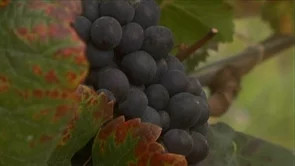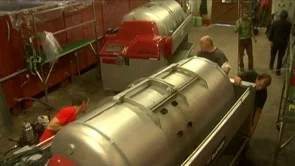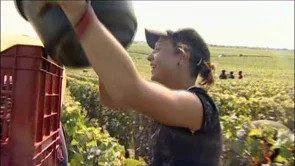-
the history
In the heart of the most prestigious vineyards of Burgundy, we have the good fortune to work climats which have been known throughout the world for centuries... A story of men and women profoundly attached to their terroir, which they seek to reveal and to share through great wines.
JEAN-NICOLAS MÉO -
The "terroirs"
-
When to taste
The best momentAppellationVintage- To find out when to drink your wine, please select an appellation and a vintage.
- Patience is rewarded! This vintage, originally austere and probably lacking in maturity, has long been ungrateful, but for several years now has been producing fine wines that brighten up meals. A fine example of mature Burgundy.
- A great classic, combining ripeness and acidity, which has always been good to drink and has never disappointed: a fine record of achievement! The few remaining bottles should be reserved for special occasions.
- A ripe, light vintage that might have seemed superficial. But this was without counting on its incredible seductive power, which has never wavered. These wines still offer astonishing pleasure, even if you might consider that they should be drunk now (but we've been saying that since 2005).
- Originally, a concentrated vintage, with beautiful black fruit aromas, but cold and austere. Today, delicate wines, archetypes of fine Burgundy, that can be drunk without restraint.
- A great classic: an ideal combination of ripeness and acidity has produced wines that are full-bodied, powerful and complete. Today, the vintage is in its heyday, so you'll enjoy drinking them, but if there are only a handful of bottles left, they should be saved for special occasions!
- Marked by the heatwave, the wines were powerful, rich and complex, with aromas of dried fruit (figs, grapes, etc.) and a very silky texture. In the end, the acidity was not bad, and aging was slow. Tasters today are astonished by them, having written off the vintage. And yet, what wines! Despite the succession of hot vintages from 2015 onwards, they remain unique in their concentration, aromatics... and the pleasure they give! It's important to keep a few of these for decades to come, as they will always make an impression. Aeration in advance is always recommended.
- A chaotic season, saved by a very pleasant month of September, ended up producing very nice grapes, after sorting, and quite ripe, too. The wines are fine and charming. The green aromas which appeared after bottling have now been largely integrated: ageing has played its role. Today, they are ready to drink.
- The 2005s are incredibly young, dense, deep, silky and structured... Unquestionably a great vintage, the greatest of the 21st century to date! We had to wait a long time for them to open, and even today, we must not neglect their preparation: opening and airing in advance, serving temperature not too cold... You can enjoy them today, while preserving one or more witnesses for decades to come.
- This is a classic, ripe year, with very gradual ageing and tannins that are still hanging on a little. The wines are impressive for their balance, but can still benefit from ageing, at least for the biggest appellations.
- A lighter vintage, full of elegance and suppleness, which it's high time you drank, if you haven't already!
- It was a genuinely cold vintage, and the wines were initially upright and acidic. Time has done its work, on some of them more quickly than expected. Most are now approachable and will remain so as long as you can tolerate a bit of austerity, a trait they'll probably never shed. Nothing wrong with this, on the contrary!
- A very ripe vintage, but with reserves of freshness, which evolved exactly as it should: now more tightly wound, the wines offer the fullness and pleasure of great sunny Burgundies, with an integration and finish that complement them admirably. Great classics! The big appellations can still wait.
- Long, precise and elegant, this is an originally fresh vintage with a serious finish, which has perhaps aged a little quickly. Most of the wines are good to drink and have probably reached their tasting plateau, which should last for several years.
- This underestimated vintage actually has a lot to offer. Its charm, palpable freshness and overall balance are a pleasure to drink. Far from being faded, on the contrary, the wines have entered their optimal tasting period.
- A ripe harvest, which produced delicate wines. Paradoxically, however, the wines have remained closed for a long time, and are only just emerging from this period of "hibernation". As a precaution, open and aerate them well in advance.
- An authentically cold vintage, with fruit that often bursts forth, 2013 is not lacking in voluptuousness. The acidity is very present and should lead us to take precautions when tasting: wines should not be served too cold, and suitable dishes (meats without sauce, fish, charcuterie, etc.) should be chosen. They can still be drunk or kept.
- A very well-balanced vintage, still quite young. Without lacking in maturity, this is not a hot vintage, and the wines express a certain uprightness. They are therefore sensitive to the context in which they are tasted: served too cold, or on a dish that is too sweet or generous, they will seem harsh; their natural finesse, on the other hand, will work wonders in an environment that is not too overwhelming. You can also choose to keep them ...
- A vintage with great potential... which it has not yet revealed. The concentration and balance between ripeness and acidity should work wonders in the future. To be kept for the time being.
- Is 2016 shaping up to be the best vintage of the decade? A warm but late year has produced some very elegant wines, easy to drink but not lacking in depth. In fact, they're wildly seductive, even if some of them have tended to close up lately. It is hard to resist opening these bottles, but be sure to keep a few for long-term cellaring.
- The 2017s have always been graceful and flattering, making them good wines to drink. Thanks to their charm, they even manage to outshine other, more robust vintages. They have now entered a transitional period, between youth and maturity but remain largely accessible, still expressing the lovely balance that has been their strength since bottling. We expect these wines to provide great pleasure over the next five to ten years.
- A very ripe vintage, with a certain concentration, whose ageing potential should not be overlooked. Bourgognes and Villages have been and can still be drunk for their smoothness, but Premier Crus and Grand Crus should be kept.
- A very ripe vintage, with some acidity. While some wines are flattering, all have great potential for improvement. Our recommendation is to keep them for now.
- A concentrated vintage, both ripe and acidic, with great potential, even for the villages. Better to keep them and resist the temptation to open them!
- A fine vintage, to enjoy right now! If 2021 is a vintage reminiscent of the Burgundies of 40 years ago, it's not a cold vintage: no biting acidity that would need time to integrate, but on the contrary, a natural finesse and complexity that make them very interesting from their youth. You can drink them, in fact we recommend it!
Complete table of wines ready to drinkSee the recommendations for tastingTo drink now To drink now or to lay down To lay down
- Domain
- Négoce
Older vintages: all wines to drink now97989900010203040506070809101112131415161718Bourgogne RougeChambolle-MusignyChambolle-Musigny les CrasChambolle-Musigny les FeusselottesClos de VougeotClos Saint-PhilibertCorton Clos RognetCorton La Vigne au SaintCorton Les PerrièresÉchezeauxFixin97989900010203040506070809101112131415161718Fixin Clos du ChapitreGevrey-ChambertinMarsannayMorey Saint-DenisNuits-Saint-GeorgesNuits-Saint-Georges aux ArgillasNuits-Saint-Georges aux BoudotsNuits-Saint-Georges aux MurgersNuits-Saint-Georges les PerrièresRichebourgVosne-RomanéeVosne-Romanée au Cros Parantoux97989900010203040506070809101112131415161718Vosne-Romanée aux BrûléesVosne-Romanée les ChaumesServing temperature
What works best: 16-18°C (61-64°F) for the reds, 12-14°C (54-57°F) for the whites.
Indeed, generally speaking, wines are served too warm ("room temperature” no longer means the same as it did 50 or 100 years ago!).
If you wish to refine this rule of thumb, the following correctives may be applied for the reds: a ripe and warm vintage, such as 2009 or 2012, should be served cool, otherwise the alcohol will dominate; a cool vintage with pronounced acidity should, on the contrary, be warmer (around 20°C or 68°F) so as to give the wine some roundness and not bring out the tannins and the acidity.
Decanting
In general, Burgundies don't need to be completely decanted into a carafe in the way the wines of Bordeaux do, but they ALWAYS need a little airing before being drunk.
The best thing is to open the wine two hours before serving it, to pour oneself a glass so as to smell it (and thus detect any possible problem) and to put the contents of this glass back into the bottle. The emulsion thus created will enable a little air to be introduced into the wine, and this will help greatly to open up the nose and the palate.
It's not really very elegant.., but perfectly efficient and respectful. In some rarer cases, we recommend that you decant and this will be indicated with a pictogram.
Lay down? Or drink straight away?
A few simple rules will be useful in most circumstances:
- young wines offer intense fruit and a brightness which won't be found later on. After bottling, you have 18 to 24 months (so 3 to 4 years after the vintage) to take advantage of that. Then the wine will close up: the aromas will not be so fresh and at the same time, the palate will not have mellowed yet. The worst of both worlds, so to speak.
- for the mouth to become less tart and for the roughness of youth to be polished out while still maintaining good aromatic liveliness, 5 to 7 years on average are required after bottling. So to be more precise and to leave a little leeway, add 7 to 10 years to the vintage. This is the point at which the right balance should be achieved and when all the complexity of the wine should begin to show itself.
- It's impossible to give a drink-by date! As it evolves, the wine's balanced phase may last a very long time. It's for you to see whether you are sensitive to the finesse and the emotion experienced when drinking an old wine.
These simple principles will work in most cases, but you must understand that the adaptations and exceptions are numerous. The less prestigious appellations are normally made to be drunk a little earlier, but a lot of pleasure can be derived with a Bourgogne or a 10-year-old Marsannay. Certain vintages mature more quickly than anticipated (2007) or, on the contrary, require more patience (2010). Certain wines are full of charm when young (Fixin, Chambolle Cras, for example), while others really need to wait to reveal their potential (most of them...). In any case, it's necessary to open the bottles in advance to oxygenate the wine (cf. "Decanting”) and to taste it at the right temperature (cf. "Serving temperature”).
But if wine-lovers are to get to know their own preferences, they must make the effort to acquire experience and self-knowledge, and what's more, these elements will constitute all their pleasure.
-
-
 Meo Camuzet
Meo Camuzet -
 Les vendanges
Les vendanges -
 La vinification
La vinification
The movie
-
-
ContactDomaine Méo-Camuzet
11, rue des Grands Crus
21700 Vosne-Romanée - France+33 3 80 61 55 55